Suggested Length of Stay
Itineraries in Iran normally start ay 7 days and work their way up to 3-4 weeks depending on your interests.
Modes of transport
Roads
Road surfaces are generally excellent. On the other hand, driving at night is more dangerous because of occasional unmarked potholes and the risk of running into tractors and other vehicles crawling along the road with no lights. On intercity roads, most signs are in English and Farsi. All cities have street signs, many in English and Farsi.
Public transport
In Iran, if you can’t get somewhere by bus (or minibus), the chances are no one wants to go there. More than 20 bus companies offer thousands of services on buses that are cheap, comfortable and frequent.
Trains
Tehran is the main hub and most services begin or end in the capital. There is at least one daily service to Mashhad, Esfahan, Tabriz, Bandar Abbas and Kerman. Trains usually depart on time, but arrival times for stops en route are often in the middle of the night.
Taxis
Almost every car in the country is available for private hire. Needless to say, prices are open to negotiation. One way to avoid getting ripped off is to ask the driver of a savari for the price per person of a certain trip then multiply it by four or five.
Flying
Iran Air is the largest among a growing roster of domestic airlines and boasts an extensive network of flights, covering most provincial capitals. Domestic prices are set by the government, so it doesn’t matter which airline you fly, the price will be the same.
Health Precautions
Take out comprehensive travel insurance before you depart to cover overseas medical costs, including medical evacuation. Make sure your policy includes adequate coverage for any pre-existing conditions.
Food and Drink
Iranian food is a highlight of travelling in the country, with considerable variety on offer. While you may often eat cheap meals on the run, remember that for many Iranians, eating is a social event in which food is only half the story.
Alcohol is banned in Iran.
Money
The unit of currency is the Iranian Rial (IRR) which is divided into 100 dinar, but the Toman is used by Iranians today as the equivalent of ten Rial. Most Iranians state the value of things in Toman instead of Rial. Prices are most often marked in Toman, with 1,000 or 1,000,000 Toman equivalent to 10,000 or 10,000,000 Rial respectively. It is best to travel with US Dollars, which can be exchanged upon arrival in the airport or banks in big cities or at the street rate at street outlets.
Time Zone
GMT +3.5 (+4.5 March to September)
Visas
You’ll need a visa to enter Iran, you can apply for a 30-day tourist visa-on-arrival.
Australian Embassy & Consulate contacts in Iran
Australian Embassy, Iran
No. 2, 23rd Street
Khalid Islambuli Ave
Tehran 15138
Ph: +98 21 8872 4456
Email: dfat-tehran@dfat.gov.au
Iran Embassy & Consulate contacts in Australia
Embassy of The Islamic Republic of Iran
25 Culgoa Circuit, O’Malley ACT 2606
Email: cbr.consular@mfa.ir
Ph: 02 6290 7000
Electricity
Electrical current is 220 volts, 50Hz. Round two-pin plugs are standard (Plug types C and F).
Getting there (stopovers)
Emirates and Qatar flies daily to Tehran from most Australian capital cities.
Tipping
Although there are many circumstances where a small tip is expected, it is unlikely that a waiter will be hovering around expectantly after delivering the bill. It’s worth remembering that helpful Iranians probably deserve some extra appreciation to supplement their meagre wages. In most cases, tipping is an optional reward for good service. Fares in private taxis are always negotiable.

Ready to discuss your trip to Iran?
Speak to one of our travel specialists and we’ll create your personalised itinerary just for you.
